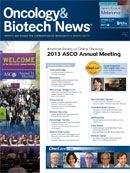T-VEC Delivers Durable Responses in Unresectable Melanoma
T-VEC manifested significant gains in durable response rate and other key clinical indicators in patients with advanced melanoma in what researchers described as the first phase III trial demonstrating the efficacy of an oncolytic virus immunotherapy.
Howard L. Kaufman, MD
Talimogene laherparepvec (T-VEC) manifested significant gains in durable response rate (DRR) and other key clinical indicators in patients with advanced melanoma in what researchers described as the first phase III trial demonstrating the efficacy of an oncolytic virus immunotherapy.
In the OPTiM trial, the overall DRR was 16.3% for patients who took T-VEC, compared with 2.1% among participants who received granulocyte-macrophage colony-stimulating factor (GM-CSF), according to data presented during the 2013 ASCO Annual Meeting. The DRR, the trial’s primary endpoint, was defined as the objective overall responses beginning within 12 months of the start of therapy and lasting ≥6 months, and higher rates were reported among T-VEC patients with less-advanced disease.
Although overall survival (OS) data are not yet mature, the trend thus far favors T-VEC, said principal investigator Howard L. Kaufman, MD, professor at Rush University Medical Center in Chicago, Illinois, and vice president of the Society for Immunotherapy of Cancer, in an interview. He said final data probably would be available by the end of this year.
Kaufman said oncolytic virus therapy “is a paradigm- changer, because this has shown therapeutic benefit in patients with cancer and is very safe to give.”
Robert Andtbacka, MD, CM
Robert Andtbacka, MD, CM, a key investigator on the study, said in an interview that T-VEC represents “a new category of immunotherapy.” Andtbacka is a surgeon and investigator with Intermountain Healthcare and the Huntsman Cancer Institute at the University of Utah in Salt Lake City.
“We have known for over a hundred years that viruses can induce an immune reaction against cancers and that that can lead to a response,” said Andtbacka. “What we have now discovered is that, through recombinant DNA technology and modifications of the virus, we can make them very specific for the cancer cells and not the normal cells.”
T-VEC is a herpes simplex type 1 virus that has been genetically modified by replacing the ICP34.5 neurovirulence gene and the ICP47 gene with the human GMCSF gene. The resulting vector achieves direct lysis of tumor cells and induces an immune response boosted by GM-CSF.
In the intent-to-treat OPTiM study population, 436 patients with unresectable stage IIIB-IV melanoma were randomized 2:1 to receive either T-VEC injected into the lesions directly or by ultrasound guidance, or GM-CSF administered subcutaneously. There were 295 patients in the T-VEC group and 141 participants in the GM-CSF arm.
T-VEC dosing was initiated as ≤4 mL x 106 pfu/mL once, then after 3 weeks as ≤4 mL x 108 pfu/mL every 2 weeks for up to 2 years or until disease progression. GM-CSF dosing was 125 μg/m2 daily every 14 days in a 28-day cycle. Those who received T-VEC were treated for a median of 23 weeks (range, 0.1-78.9 weeks), more than double the 10-week median (range, 0.6- 72.0 weeks) for those in the GM-CSF group.
The trial met its primary endpoint of DRR, with a statistically significant unadjusted odds ratio of 8.9 (P <.0001) favoring T-VEC.
In a subset analysis, the DRR was most enhanced for patients with nonvisceral stage IIIB/C disease (33%) and stage IV M1a disease (16%), and for those treated with T-VEC as a first-line therapy (24%).
The objective overall response (ORR) rate was 26.4% among the T-VEC group, including 10.8% with a complete response, compared with an ORR of 5.7% and a complete response of 0.7% in the GM-CSF group.
In a planned interim analysis, the OS for patients treated with T-VEC was a median 23.3 months, compared with 19.0 months for the GM-CSF patients for a hazard ratio of 0.79 (P <.07). The number of required events has not yet reached the required level for primary OS analysis, but the survival curves are trending toward significance, according to the data.
In terms of safety and tolerability, there were more adverse events (AEs) reported in the T-VEC arm than in the GM-CSF group. The most frequently reported AEs of all grades for the T-VEC versus GMCSF arms were fatigue (50.3% vs 36.2%, respectively), chills (48.6% vs 8.7%), and pyrexia (42.8% vs 8.7%). Grade 3/4 AEs were limited, with cellulitis affecting 2.1% of patients in the T-VEC arm as the most pronounced. None of the 10 fatalities in the T-VEC arm were considered treatment-related.
Andtbacka RHI, Collichio FA, Amatruda T, et al. OPTiM: a randomized phase III trial of talimogene laherparepvec (T-VEC) versus subcutaneous (SC) granulocyte-macrophage colony-stimulating factor (GM-CSF) for the treatment (tx) of unresected stage IIIB/C and IV melanoma. J Clin Oncol. 2013;31(suppl; abstr LBA9008).




